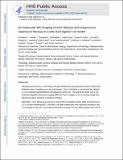3D molecular MR imaging of liver fibrosis and response to rapamycin therapy in a bile duct ligation rat model
Author(s)
Farrar, Christian T.; DePeralta, Danielle K.; Day, Helen; Rietz, Tyson A.; Wei, Lan; Lauwers, Gregory Y.; Keil, Boris; Subramaniam, Arun; Tanabe, Kenneth K.; Fuchs, Bryan C.; Caravan, Peter; Sinskey, Anthony J; ... Show more Show less
DownloadSinskey_3D molecular.pdf (1.214Mb)
PUBLISHER_CC
Publisher with Creative Commons License
Creative Commons Attribution
Terms of use
Metadata
Show full item recordAbstract
Background & Aims
Liver biopsy, the gold standard for assessing liver fibrosis, suffers from limitations due to sampling error and invasiveness. There is therefore a critical need for methods to non-invasively quantify fibrosis throughout the entire liver. The goal of this study was to use molecular Magnetic Resonance Imaging (MRI) of Type I collagen to non-invasively image liver fibrosis and assess response to rapamycin therapy.
Methods
Liver fibrosis was induced in rats by bile duct ligation (BDL). MRI was performed 4, 10, or 18 days following BDL. Some BDL rats were treated daily with rapamycin starting on day 4 and imaged on day 18. A three-dimensional (3D) inversion recovery MRI sequence was used to quantify the change in liver longitudinal relaxation rate (ΔR1) induced by the collagen-targeted probe EP-3533. Liver tissue was subjected to pathologic scoring of fibrosis and analyzed for Sirius Red staining and hydroxyproline content.
Results
ΔR1 increased significantly with time following BDL compared to controls in agreement with ex vivo measures of increasing fibrosis. Receiver operating characteristic curve analysis demonstrated the ability of ΔR1 to detect liver fibrosis and distinguish intermediate and late stages of fibrosis. EP-3533 MRI correctly characterized the response to rapamycin in 11 out of 12 treated rats compared to the standard of collagen proportional area (CPA). 3D MRI enabled characterization of disease heterogeneity throughout the whole liver.
Conclusions
EP-3533 allowed for staging of liver fibrosis, assessment of response to rapamycin therapy, and demonstrated the ability to detect heterogeneity in liver fibrosis.
Date issued
2015-05Department
Massachusetts Institute of Technology. Department of BiologyJournal
Journal of Hepatology
Publisher
Elsevier
Citation
Farrar, Christian T., DePeralta, Danielle K.; Day, Helen; et al. “3D Molecular MR Imaging of Liver Fibrosis and Response to Rapamycin Therapy in a Bile Duct Ligation Rat Model.” Journal of Hepatology 63, no. 3 (September 2015): 689–696. © 2015 European Association for the Study of the Liver.
Version: Author's final manuscript
ISSN
0168-8278